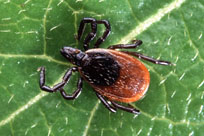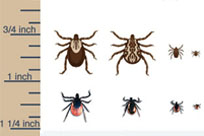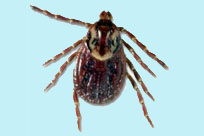Everyone living in Westchester needs to be able to identify a deer tick, even if you do not spend a lot of time outdoors. Know the difference between the deer tick which carries Lyme disease, and a dog tick, which does not carry the disease.

The stages of Ixodes scapularis, the black-legged or deer tick: larva, nymph, adult.

A female black-legged deer tick, Ixodes scapularis.

A male deer tick

Top Row: Dermacentor variabilis, the American dog tick, which is not thought to transmit Lyme disease. Left to right: adult male, adult male dorsal side, nymph, larva. Adults are most common in May, June, and July. Note that the adult dog ticks are somewhat larger than adult deer ticks, and have characteristic white markings on the dorsal (top) side.
Bottom Row: Ixodes scapularis (dammini), the deer tick which transmits Lyme disease. Left to right: adult female, nymph, younger nymph, larva. Nymphs are most common May through July. Adults appear in the fall and early spring.

An adult deer tick (left) and an engorged deer tick filled with blood (right).

An American dog tick
